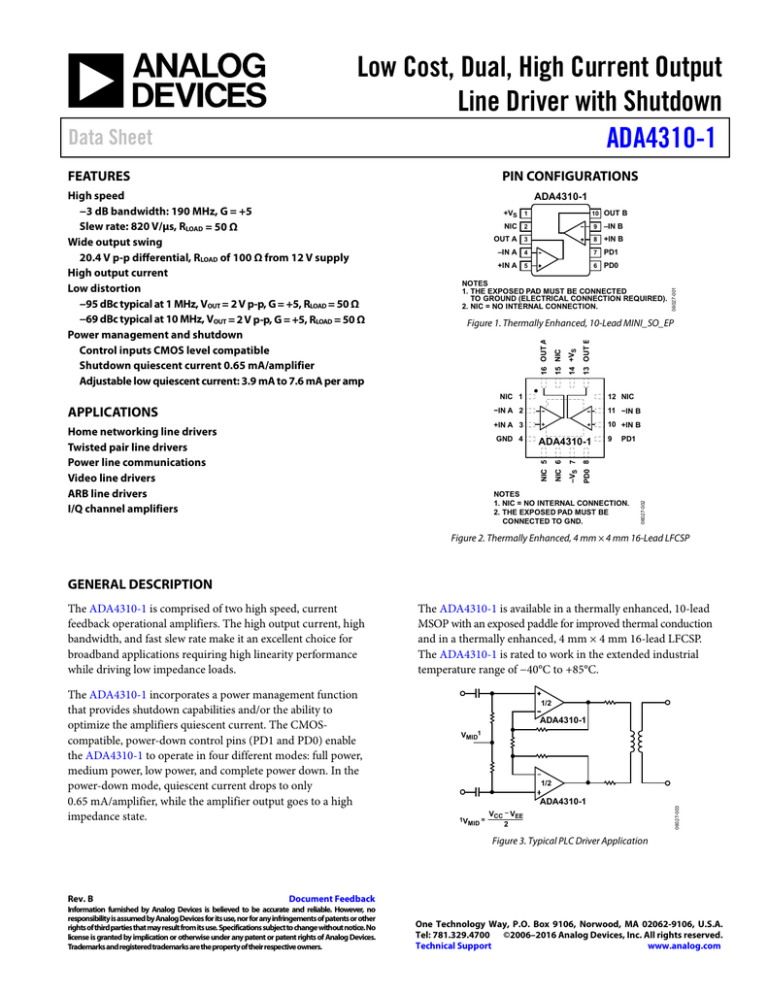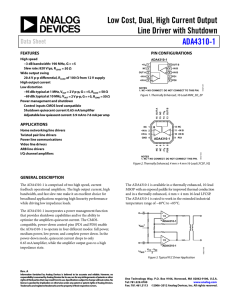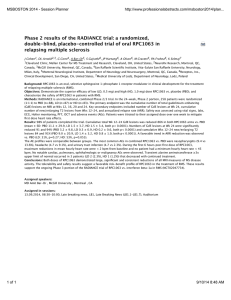
FEATURES
PIN CONFIGURATIONS
+VS 1
10
OUT B
NIC 2
9
–IN B
OUT A 3
8
+IN B
–IN A 4
7
PD1
+IN A 5
6
PD0
NOTES
1. THE EXPOSED PAD MUST BE CONNECTED
TO GROUND (ELECTRICAL CONNECTION REQUIRED).
2. NIC = NO INTERNAL CONNECTION.
06027-001
ADA4310-1
13 OUT B
14 +VS
Figure 1. Thermally Enhanced, 10-Lead MINI_SO_EP
16 OUT A
NIC 1
10 +IN B
ADA4310-1
NIC 5
GND 4
–VS 7
+IN A 3
9
PD1
PD0 8
Home networking line drivers
Twisted pair line drivers
Power line communications
Video line drivers
ARB line drivers
I/Q channel amplifiers
12 NIC
11 −IN B
NIC 6
APPLICATIONS
−IN A 2
NOTES
1. NIC = NO INTERNAL CONNECTION.
2. THE EXPOSED PAD MUST BE
CONNECTED TO GND.
06027-002
High speed
−3 dB bandwidth: 190 MHz, G = +5
Slew rate: 820 V/µs, RLOAD = 50 Ω
Wide output swing
20.4 V p-p differential, RLOAD of 100 Ω from 12 V supply
High output current
Low distortion
−95 dBc typical at 1 MHz, VOUT = 2 V p-p, G = +5, RLOAD = 50 Ω
−69 dBc typical at 10 MHz, VOUT = 2 V p-p, G = +5, RLOAD = 50 Ω
Power management and shutdown
Control inputs CMOS level compatible
Shutdown quiescent current 0.65 mA/amplifier
Adjustable low quiescent current: 3.9 mA to 7.6 mA per amp
15 NIC
Data Sheet
Low Cost, Dual, High Current Output
Line Driver with Shutdown
ADA4310-1
Figure 2. Thermally Enhanced, 4 mm × 4 mm 16-Lead LFCSP
GENERAL DESCRIPTION
The ADA4310-1 incorporates a power management function
that provides shutdown capabilities and/or the ability to
optimize the amplifiers quiescent current. The CMOScompatible, power-down control pins (PD1 and PD0) enable
the ADA4310-1 to operate in four different modes: full power,
medium power, low power, and complete power down. In the
power-down mode, quiescent current drops to only
0.65 mA/amplifier, while the amplifier output goes to a high
impedance state.
The ADA4310-1 is available in a thermally enhanced, 10-lead
MSOP with an exposed paddle for improved thermal conduction
and in a thermally enhanced, 4 mm × 4 mm 16-lead LFCSP.
The ADA4310-1 is rated to work in the extended industrial
temperature range of −40°C to +85°C.
1/2
ADA4310-1
VMID1
1/2
ADA4310-1
=
1V
MID
VCC – VEE
2
06027-003
The ADA4310-1 is comprised of two high speed, current
feedback operational amplifiers. The high output current, high
bandwidth, and fast slew rate make it an excellent choice for
broadband applications requiring high linearity performance
while driving low impedance loads.
Figure 3. Typical PLC Driver Application
Rev. B
Document Feedback
Information furnished by Analog Devices is believed to be accurate and reliable. However, no
responsibility is assumed by Analog Devices for its use, nor for any infringements of patents or other
rights of third parties that may result from its use. Specifications subject to change without notice. No
license is granted by implication or otherwise under any patent or patent rights of Analog Devices.
Trademarks and registered trademarks are the property of their respective owners.
One Technology Way, P.O. Box 9106, Norwood, MA 02062-9106, U.S.A.
Tel: 781.329.4700 ©2006–2016 Analog Devices, Inc. All rights reserved.
Technical Support
www.analog.com
ADA4310-1
Data Sheet
TABLE OF CONTENTS
Features .............................................................................................. 1
Application Information ................................................................ 11
Applications ....................................................................................... 1
Feedback Resistor Selection ...................................................... 11
Pin Configurations ........................................................................... 1
Power Control Modes of Operation ........................................ 11
General Description ......................................................................... 1
Exposed Thermal Pad Connections ........................................ 11
Revision History ............................................................................... 2
Power Line Application ............................................................. 11
Specifications..................................................................................... 3
Board Layout ............................................................................... 12
Absolute Maximum Ratings ............................................................ 5
Power Supply Bypassing ............................................................ 12
Thermal Resistance ...................................................................... 5
Outline Dimensions ....................................................................... 13
ESD Caution .................................................................................. 5
Ordering Guide .......................................................................... 13
Pin Configurations and Function Descriptions ........................... 6
Notes................................................................................................. 14
Typical Performance Characteristics ............................................. 7
Theory of Operation ...................................................................... 10
REVISION HISTORY
5/2016—Rev. A to Rev. B
Changed CP-16-4 to CP-16-23 .................................... Throughout
Changes to Figure 1 and Figure 2 ................................................... 1
Changes to Table 2, Table 3, and Maximum Power Dissipation
Section ................................................................................................ 5
Changes to Figure 5, Figure 6, Table 5, and Table 6 ..................... 6
Updates Outline Dimensions ........................................................ 13
Changes to Ordering Guide .......................................................... 13
8/2012—Rev. 0 to Rev. A
Added EPAD Notation to Figure 5 and Figure 6 ..........................6
Updated Outline Dimensions ....................................................... 13
Changes to Ordering Guide .......................................................... 13
8/2006—Revision 0: Initial Version
Rev. B | Page 2 of 14
Data Sheet
ADA4310-1
SPECIFICATIONS
VBBSBB = 12 V, ±6 V (@ TBBABB = 25°C, G = +5, RBBLBB = 100 Ω, unless otherwise noted).
Table 1.
Parameter
DYNAMIC PERFORMANCE
−3 dB Bandwidth
Slew Rate
NOISE/DISTORTION PERFORMANCE
Distortion (Worst Harmonic)
Input Voltage Noise
Input Current Noise
DC PERFORMANCE
Input Offset Voltage
Input Bias Current
Noninverting Input
Inverting Input
Open-Loop Transimpedance
Common-Mode Rejection
INPUT CHARACTERISTICS
Input Resistance
OUTPUT CHARACTERISTICS
Single-Ended +Swing
Single-Ended −Swing
Single-Ended +Swing
Single-Ended −Swing
Differential Swing
POWER SUPPLY
Operating Range (Dual Supply)
Operating Range (Single Supply)
Supply Current
Test Conditions/Comments
Min
G = +5, VOUT = 0.1 V p-p, PD1 = 0, PD0 = 0
PD1 = 0, PD0 = 1
PD1 = 1, PD0 = 0
G = +5, VOUT = 2 V p-p, RLOAD = 50 Ω, PD1 = 0, PD0 = 0
PD1 = 0, PD0 = 1
PD1 = 1, PD0 = 0
Typ
Max
Unit
190
140
100
820
790
750
MHz
MHz
MHz
V/µs
V/µs
V/µs
−95
−88
−77
dBc
dBc
dBc
−69
−57
−47
dBc
dBc
dBc
−50
−42
−35
2.85
21.8
dBc
dBc
dBc
nV/√Hz
pA/√Hz
1
mV
−2
6
µA
µA
RLOAD = 50 Ω
RLOAD = 100 Ω
14
35
−62
MΩ
MΩ
dB
f < 100 kHz
500
kΩ
RLOAD = 50 Ω
RLOAD = 50 Ω
RLOAD = 100 Ω
RLOAD = 100 Ω
RLOAD = 100 Ω
+5.08
−5.12
+5.14
−5.17
20.4
VP
VP
VP
VP
V p-p
fC = 1 MHz, VOUT = 2 V p-p, RLOAD = 50 Ω
PD1 = 0, PD0 = 0
PD1 = 0, PD0 = 1
PD1 = 1, PD0 = 0
fC = 10 MHz, VOUT = 2 V p-p, RLOAD = 50 Ω
PD1 = 0, PD0 = 0
PD1 = 0, PD0 = 1
PD1 = 1, PD0 = 0
fC = 20 MHz, VOUT = 2 V p-p, RLOAD = 50 Ω
PD1 = 0, PD0 = 0
PD1 = 0, PD0 = 1
PD1 = 1, PD0 = 0
f = 100 kHz
f = 100 kHz
±2.5
+5
PD1 = 0, PD0 = 0
PD1 = 0, PD0 = 1
PD1 = 1, PD0 = 0
PD1 = 1, PD0 = 1
±6
+12
7.6
5.6
3.9
0.65
Rev. B | Page 3 of 14
V
V
mA/amp
mA/amp
mA/amp
mA/amp
ADA4310-1
Parameter
POWER DOWN PINS
PD1, PD0 Threshold
PD1, PD0 = 0 Pin Bias Current
PD1, PD0 = 1 Pin Bias Current
Enable/Disable Time
Power Supply Rejection Ratio
Data Sheet
Test Conditions/Comments
Min
Typ
Referenced to GND
PD1 or PD0 = 0 V
PD1 or PD0 = 3 V
1.5
−0.2
70
Positive/Negative
−70/−60
Max
0.04/2
Rev. B | Page 4 of 14
Unit
V
µA
µA
µs
dB
Data Sheet
ADA4310-1
ABSOLUTE MAXIMUM RATINGS
performance of the amplifiers. Exceeding a junction temperature of
150°C for an extended period can result in changes in silicon
devices, potentially causing degradation or loss of functionality.
Parameter
Supply Voltage
10-Lead MINI_SO_EP
16-Lead LFCSP
Power Dissipation
Storage Temperature Range
Operating Temperature Range
Lead Temperature (Soldering 10 sec)
Junction Temperature
Rating
12 V
±6V
(TJMAX − TA)/θJA
−65°C to +125°C
−40°C to +85°C
300°C
150°C
Stresses at or above those listed under Absolute Maximum
Ratings may cause permanent damage to the product. This is a
stress rating only; functional operation of the product at these
or any other conditions above those indicated in the operational
section of this specification is not implied. Operation beyond
the maximum operating conditions for extended periods may
affect product reliability.
THERMAL RESISTANCE
Figure 4 shows the maximum safe power dissipation in the
package vs. the ambient temperature for the 10-lead MINI_SO_EP
(44°C/W) and for the 16-lead LFCSP (63°C/W) on a JEDEC
standard 4-layer board. θJA values are approximations.
5.0
4.5
MAXIMUM POWER DISSIPATION (W)
Table 2.
3.5
MINI_SO_EP-10
3.0
2.5
LFCSP_VQ-16
2.0
1.5
1.0
0
–35
–15
5
25
45
AMBIENT TEMPERATURE (°C)
65
85
06027-016
0.5
θJA is specified for the worst-case conditions, that is, θJA is
specified for device soldered in circuit board for surface-mount
packages.
Figure 4. Maximum Power Dissipation vs. Temperature for a 4-Layer Board
Table 3.
Package Type
10-Lead MINI_SO_EP
16-Lead LFCSP
4.0
θJA
44
63
ESD CAUTION
Unit
°C/W
°C/W
Maximum Power Dissipation
The maximum safe power dissipation for the ADA4310-1 is
limited by the associated rise in junction temperature (TJ) on
the die. At approximately 150C, which is the glass transition
temperature, the plastic changes its properties. Even temporarily
exceeding this temperature limit can change the stresses that the
package exerts on the die, permanently shifting the parametric
Rev. B | Page 5 of 14
ADA4310-1
Data Sheet
13 OUT B
14 +VS
16 OUT A
15 NIC
PIN CONFIGURATIONS AND FUNCTION DESCRIPTIONS
NIC 1
8
+IN B
–IN A 4
7
PD1
+IN A 5
6
PD0
NOTES
1. THE EXPOSED PAD MUST BE CONNECTED
TO GROUND (ELECTRICAL CONNECTION REQUIRED).
2. NIC = NO INTERNAL CONNECTION.
10 +IN B
GND 4
ADA4310-1
9
PD1
NOTES
1. NIC = NO INTERNAL CONNECTION.
2. THE EXPOSED PAD MUST BE
CONNECTED TO GND.
06027-002
OUT A 3
+IN A 3
–VS 7
–IN B
PD0 8
OUT B
9
11 −IN B
NIC 5
10
NIC 2
06027-101
+VS 1
12 NIC
−IN A 2
NIC 6
ADA4310-1
Figure 6. 16-Lead LFCSP Pin Configuration
Figure 5. 10-Lead MSOP Pin Configuration
Table 4. 10-Lead MSOP Pin Function Description
Table 5. 16-Lead LFCSP Pin Function Description
Pin No.
1
2
3
4
5
6
7
8
9
10
11 (Exposed
Paddle)
Pin No.
1, 5, 6, 12, 15
2
3
4
7
8
9
10
11
13
14
16
17 (Exposed
Paddle)
Mnemonic
+VS
NIC
OUT A
−IN A
+IN A
PD0
PD1
+IN B
−IN B
OUT B
GND
Description
Positive Power Supply Input
No Internal Connection
Amplifier A Output
Amplifier A Inverting Input
Amplifier A Noninverting Input
Power Dissipation Control
Power Dissipation Control
Amplifier B Noninverting Input
Amplifier B Inverting Input
Amplifier B Output
Ground (Electrical Connection
Required)
Rev. B | Page 6 of 14
Mnemonic
NIC
−IN A
+IN A
GND
−VS
PD0
PD1
+IN B
−IN B
OUT B
+VS
OUT A
GND
Description
No Internal Connection
Amplifier A Inverting Input
Amplifier A Noninverting Input
Ground
Negative Power Supply Input
Power Dissipation Control
Power Dissipation Control
Amplifier B Noninverting Input
Amplifier B Inverting Input
Amplifier B Output
Positive Power Supply Input
Amplifier A Output
Ground
Data Sheet
ADA4310-1
TYPICAL PERFORMANCE CHARACTERISTICS
12
–20
VOUT = 100mV p-p
RL = 50Ω
PD1, PD0 = 0, 0
9
–30
G = +2
HARMONIC DISTORTION (dBc)
G = +5
0
–3
G = +10
–6
G = +20
–9
–12
–60
–70
10
100
1000
PD1, PD0 = 0, 1
PD1, PD0 = 0, 0
–80
–90
–100
–120
0.1
06027-022
1
FREQUENCY (MHz)
23
10
100
Figure 10. Harmonic Distortion vs. Frequency
100
VOUT = 100mV p-p
G = +5
RL = 50Ω
20
1
FREQUENCY (MHz)
Figure 7. Small Signal Frequency Response for Various Closed-Loop Gains
PD1, PD0 = 0, 0
VOLTAGE NOISE (nV/√Hz)
17
14
11
GAIN (dB)
PD1, PD0 = 1, 0
–110
–15
–18
–40
–50
06027-023
NORMALIZED GAIN (dB)
6
3
HD2
HD3
VOUT = 2V p-p
RL = 50Ω
G = +5
PD1, PD0 = 0, 1
8
5
PD1, PD0 = 1, 0
2
–1
10
–4
–7
10
100
1000
FREQUENCY (MHz)
1
10
RL = 100Ω
–45
1000
–90
10k
100k
1M
10M
100M
1G
Figure 11. Voltage Noise vs. Frequency
0°
10000
1k
FREQUENCY (Hz)
Figure 8. Small Signal Frequency Response for Various Modes
100000
100
06027-012
1
06027-021
–10
0.20
0.15
G = +5
RL = 50Ω
10ns/DIV
10
–180
1
–225
OUTPUT (V)
–135
PHASE (Degrees)
100
0.05
0
–0.05
–0.10
0.1
0.0001
0.001
0.01
0.1
1
10
100
–270
1000
FREQUENCY (MHz)
Figure 9. Open-Loop Transimpedance Gain and Phase vs. Frequency
06027-020
–0.15
06027-013
MAGNITUDE (kΩ)
0.10
–0.20
Figure 12. Small Signal Transient Response
Rev. B | Page 7 of 14
ADA4310-1
–40
PD1, PD0 = (0, 0)
RL = 100Ω
PD1, PD0 = (1,1)
–10
–60
FEEDTHROUGH (dB)
–20
–30
–40
–50
–80
–100
0.1
1
10
100
1000
FREQUENCY (MHz)
–120
1
10
PD1, PD0 = (1,1)
100
–20
–30
OUTPUT IMPEDANCE (kΩ)
+PSR
–40
–PSR
–50
–60
10
1
0.1
0.01
0.1
1
10
100
1000
FREQUENCY (MHz)
0.001
0.01
06027-006
–80
0.01
1
10
100
FREQUENCY (MHz)
Figure 17. Output Impedance vs. Frequency (Disabled)
Figure 14. Power Supply Rejection(PSR) vs. Frequency
100
0.1
2.5
PD1, PD0 = (0, 0)
2.0
10ns/DIV
VOUT
10
VOLTAGE (V)
1.5
1
VPD0 , VPD1
1.0
0.5
0.1
1
10
100
1000
FREQUENCY (MHz)
06027-009
0
0.01
0.1
06027-011
POWER SUPPLY REJECTION (dB)
1000
–70
OUTPUT IMPEDANCE (Ω)
1000
Figure 16. Off-Isolation vs. Frequency
G = +5
PD1, PD0 = (0, 0)
RL = 100Ω
–10
1000
FREQUENCY (MHz)
Figure 13. Common-Mode Rejection(CMR) vs. Frequency
0
100
06027-010
–70
0.01
06027-008
–60
06027-007
COMMON-MODE REJECTION (dB)
0
Data Sheet
–0.5
Figure 18. Power-Down Turn On/Turn Off
Figure 15. Closed-Loop Output Impedance vs. Frequency
Rev. B | Page 8 of 14
Data Sheet
ADA4310-1
0
–40
–60
–80
–100
–120
0.1
1
10
FREQUENCY (MHz)
100
1000
06027-014
CROSSTALK (dB)
–20
Figure 19. Crosstalk
Rev. B | Page 9 of 14
ADA4310-1
Data Sheet
THEORY OF OPERATION
The ADA4310-1 is a current feedback amplifier with high
output current capability. With a current feedback amplifier, the
current into the inverting input is the feedback signal, and the
open-loop behavior is that of a transimpedance, dVO/dIIN or TZ.
The open-loop transimpedance is analogous to the open-loop
voltage gain of a voltage feedback amplifier. Figure 20 shows a
simplified model of a current feedback amplifier. Because RIN is
proportional to 1/gm, the equivalent voltage gain is just TZ × gm,
where gm is the transconductance of the input stage. Basic
analysis of the follower with gain circuit yields
Because G × RIN << RF for low gains, a current feedback
amplifier has relatively constant bandwidth vs. gain, the 3 dB
point being set when |TZ| = RF.
Of course, for a real amplifier there are additional poles that
contribute excess phase, and there is a value for RF below which
the amplifier is unstable. Tolerance for peaking and desired
flatness determines the optimum RF in each application.
RF
RG
VO
TZ s
G
VIN
TZ s G RIN RF
RIN
IIN
where:
VOUT
RF
RG
06027-017
VIN
G 1
R IN
TZ
RN
Figure 20. Simplified Block Diagram
1
50 Ω
gm
Rev. B | Page 10 of 14
Data Sheet
ADA4310-1
APPLICATION INFORMATION
Gain
+2
+5
+5
+10
+20
RG (Ω)
499
124
249
55.4
26.1
−3 dB SS BW (MHz)
230
190
125
160
115
Conditions: VS = ±6 V, TA = 25°C, RL = 50 Ω, PD1, PD0 = 0,0.
Applications (that is, powerline AV modems) requiring greater
than 10 dBm peak power should consider using an external line
driver, such as the ADA4310-1. Figure 21 shows an example
interface between the TxDAC® output and ADA4310-1 biased
for single-supply operation. The TxDAC’s peak-to-peak differential output voltage swing should be limited to 2 V p-p, with
the ADA4310-1s gain configured to realize the additional
voltage gain required by the application. A low-pass filter
should be considered to filter the DAC images inherent in the
signal reconstruction process. In addition, dc blocking capacitors
are required to level-shift the TxDAC’s output signal to the
common-mode level of the ADA4310-1 (that is, AVDD/2).
0.1µF
REFIO
1
RF (Ω)
499
499
1k
499
499
POWER LINE APPLICATION
POWER CONTROL MODES OF OPERATION
The ADA4310-1 features four power modes: full power, ¾
power, ½ power, and shutdown. The power modes are
controlled by two logic pins, PD0 and PD1. The power-down
control pins are compatible with standard 3 V and 5 V CMOS
logic. Table 7 shows the various power modes and associated
logic states. In the power-down mode, the output of the
amplifier goes into a high-impedance state.
Table 7. Power Modes
PD1
Low
Low
High
High
PD0
Low
High
Low
High
Power Mode
Full Power
¾ Power
½ Power
Power Down
Total Supply
Current (mA)
15.2
11.2
7.8
1.3
Output
Impedance
Low
Low
Low
High
EXPOSED THERMAL PAD CONNECTIONS
The exposed thermal pad on the 10-lead MSOP package is both
the reference for the PD pins and the only electrical connection
for the negative supply voltage. Therefore, in the 10-lead MSOP
package, the ADA4310-1 can only be used on a single supply.
The exposed thermal pad MUST be connected to ground.
Failure to do so will render the part inoperable.
The 4 mm × 4 mm 16-lead LFCSP package has dedicated pins
for both the positive and negative supplies, and it can be used
in either single supply or dual supply applications. There is no
electrical connection for the exposed thermal pad. Although the
pad could theoretically be connected to any potential, it is still
typically connected to ground.
Rev. B | Page 11 of 14
RSET
1/2
OPTIONAL
LCLPF
ADA4310-1
IOUTP+
AVDD/2
TxDAC
IOUTP–
0dB TO –7.5dB
1/2
ADA4310-1
Figure 21. TxDAC Output Directly via Center-Tap Transformer
06027-019
Table 6. Recommended Values and Frequency Performance1
A requirement for both packages is that the thermal pad be
connected to a solid plane with low thermal resistance, ensuring
adequate heat transfer away from the die and into the board.
TxDISABLE
The feedback resistor has a direct impact on the closed-loop
bandwidth and stability of the current feedback op amp.
Reducing the resistance below the recommended value can
make the amplifier response peak and even become unstable.
Increasing the size of the feedback resistor beyond the recommended value reduces the closed-loop bandwidth. Table 6
provides a convenient reference for quickly determining the
feedback and gain resistor values, and the corresponding
bandwidth, for common gain configurations. The recommended
value of feedback resistor for the ADA4310-1 is 499 Ω.
REFADJ
FEEDBACK RESISTOR SELECTION
ADA4310-1
Data Sheet
BOARD LAYOUT
POWER SUPPLY BYPASSING
As is the case with all high speed applications, careful attention
to printed circuit board layout details prevents associated board
parasitics from becoming problematic. Proper RF design
technique is mandatory. The PCB should have a ground plane
covering all unused portions of the component side of the
board to provide a low impedance return path. Removing the
ground plane on all layers from the area near the input and
output pins reduces stray capacitance, particularly in the area of
the inverting inputs. Signal lines connecting the feedback and
gain resistors should be as short as possible to minimize the
inductance and stray capacitance associated with these traces.
Termination resistors and loads should be located as close as
possible to their respective inputs and outputs. Input and output
traces should be kept as far apart as possible to minimize
coupling (crosstalk) though the board. Wherever there are
complementary signals, a symmetrical layout should be
provided to the extent possible to maximize balanced
performance. When running differential signals over a long
distance, the traces on the PCB should be close. This reduces
the radiated energy and makes the circuit less susceptible to RF
interference. Adherence to stripline design techniques for long
signal traces (greater than about 1 inch) is recommended.
The ADA4310-1 operates on supplies, from +5 V to ±6 V. The
ADA4310-1 circuit should be powered with a well-regulated
power supply. Careful attention must be paid to decoupling the
power supply. High quality capacitors with low equivalent series
resistance (ESR), such as multilayer ceramic capacitors
(MLCCs), should be used to minimize supply voltage ripple and
power dissipation. In addition, 0.1 µF MLCC decoupling
capacitors should be located no more than ⅛-inch away from
each of the power supply pins. A large, usually tantalum, 10 µF
capacitor is required to provide good decoupling for lower
frequency signals and to supply current for fast, large signal
changes at the ADA4310-1 outputs. Bypassing capacitors should
be laid out in such a manner to keep return currents away from
the inputs of the amplifiers. This minimizes any voltage drops
that can develop due to ground currents flowing through the
ground plane. A large ground plane also provides a low
impedance path for the return currents.
For more information on high speed board layout, go to
www.analog.com and A Practical Guide to High-Speed PrintedCircuit-Board Layout.
Rev. B | Page 12 of 14
Data Sheet
ADA4310-1
OUTLINE DIMENSIONS
3.10
3.00
2.90
1
0.50
BSC
0.95
0.85
0.75
5.05
4.90
4.75
1.760
1.660
1.560
EXPOSED
PAD
5
TOP VIEW
FOR PROPER CONNECTION OF
THE EXPOSED PAD, REFER TO
THE PIN CONFIGURATION AND
FUNCTION DESCRIPTIONS
SECTION OF THIS DATA SHEET.
BOTTOM VIEW
2.00 BSC
SIDE VIEW
0.13
MAX
COPLANARITY
0.10
PKG-3009
6
1.10
MAX
0.25 GAGE
PLANE
0.23
0.08
END VIEW
6°
0°
0.33
0.17
0.70
0.55
0.40
0.95
REF
06-04-2013-C
10
3.10
3.00
2.90
1.825
1.725
1.625
COMPLIANT TO JEDEC STANDARDS MO-187-BA-T
Figure 22. 10-Lead Mini Small Outline Package with Exposed Pad [MINI_SO_EP]
(RH-10-1)
Dimensions shown in millimeters
DETAIL A
(JEDEC 95)
0.35
0.30
0.25
0.65
BSC
13
PIN 1
INDIC ATOR AREA OPTIONS
(SEE DETAIL A)
16
1
12
2.25
2.10 SQ
1.95
EXPOSED
PAD
9
TOP VIEW
PKG-004025/5112
0.80
0.75
0.70
SEATING
PLANE
0.70
0.60
0.50
4
5
8
BOTTOM VIEW
0.05 MAX
0.02 NOM
COPLANARITY
0.08
0.203 REF
0.25 MIN
FOR PROPER CONNECTION OF
THE EXPOSED PAD, REFER TO
THE PIN CONFIGURATION AND
FUNCTION DESCRIPTIONS
SECTION OF THIS DATA SHEET.
COMPLIANT TO JEDEC STANDARDS MO-220-WGGC.
04-15-2016-A
PIN 1
INDICATOR
4.10
4.00 SQ
3.90
Figure 23. 16-Lead Lead Frame Chip Scale Package [LFCSP]
4 mm × 4 mm Body and 0.75 mm Package Height
(CP-16-23)
Dimensions shown in millimeters
ORDERING GUIDE
Model1
ADA4310-1ARHZ-RL
ADA4310-1ARHZ-R7
ADA4310-1ARHZ
ADA4310-1ACPZ-RL
ADA4310-1ACPZ-R2
ADA4310-1ACPZ-R7
1
Temperature
Package
−40°C to +85°C
−40°C to +85°C
−40°C to +85°C
−40°C to +85°C
−40°C to +85°C
−40°C to +85°C
Package Description
10-Lead Mini Small Outline Package with Exposed Pad [MINI_SO_EP]
10-Lead Mini Small Outline Package with Exposed Pad [MINI_SO_EP]
10-Lead Mini Small Outline Package with Exposed Pad [MINI_SO_EP]
16-Lead Lead Frame Chip Scale Package [LFCSP]
16-Lead Lead Frame Chip Scale Package [LFCSP]
16-Lead Lead Frame Chip Scale Package [LFCSP]
Z = RoHS Compliant Part.
Rev. B | Page 13 of 14
Package
Option
RH-10-1
RH-10-1
RH-10-1
CP-16-23
CP-16-23
CP-16-23
Branding
0L
0L
0L
ADA4310-1
Data Sheet
NOTES
©2006–2016 Analog Devices, Inc. All rights reserved. Trademarks and
registered trademarks are the property of their respective owners.
D06027-0-5/16(B)
Rev. B | Page 14 of 14
Mouser Electronics
Authorized Distributor
Click to View Pricing, Inventory, Delivery & Lifecycle Information:
Analog Devices Inc.:
ADA4310-1ACPZ-R7 ADA4310-1ACPZ-RL ADA4310-1ARHZ ADA4310-1ARHZ-R7 ADA4310-1ARHZ-RL
ADA4310-1ACPZ-R2






